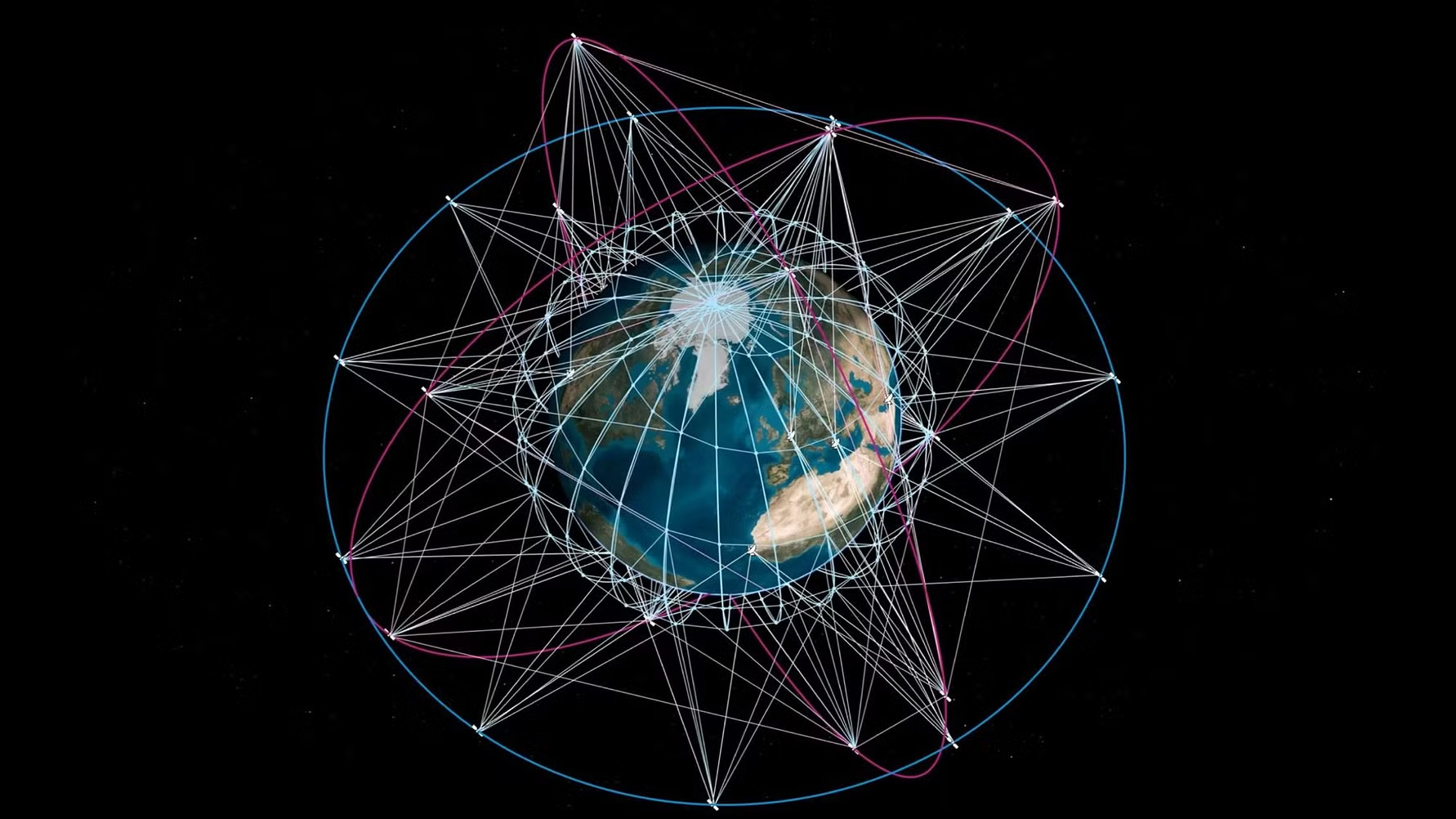Growing risks in low Earth orbit demand more responsible space behavior
Monday, 16 December 2024 15:00

Antimatter propulsion is still far away, but it could change everything
Monday, 16 December 2024 14:49This request seems a bit unusual, so we need to confirm that you're human. Please press and hold the button until it turns completely green. Thank you for your cooperation!
Press and hold the button
If you believe this is an error, please contact our support team.
185.132.36.159 : bead74e7-d1cf-48dc-ba44-400015f9
Planet-forming discs lived longer in early Universe
Monday, 16 December 2024 14:00
Our understanding of planet formation in the Universe’s early days is challenged by new data from the NASA/ESA/CSA James Webb Space Telescope. Webb solved a puzzle by proving a controversial finding made with the NASA/ESA Hubble Space Telescope more than 20 years ago.
Why the Earth observation business model is flawed – and what must change
Monday, 16 December 2024 13:00

China kicks off Guowang megaconstellation with Long March 5B launch
Monday, 16 December 2024 11:39

EU kickstarts satellite network to rival Musk's Starlink
Monday, 16 December 2024 11:37 The EU's flagship satellite constellation project officially took off Monday, as the bloc signed a concession contract with a European consortium to develop a secure space-based communication system.
Envisaging a multi-orbital network of almost 300 satellites, Iris? aims to rival US satellite internet service providers such as Elon Musk's Starlink and Amazon's Project Kuiper.
"This cutti
The EU's flagship satellite constellation project officially took off Monday, as the bloc signed a concession contract with a European consortium to develop a secure space-based communication system.
Envisaging a multi-orbital network of almost 300 satellites, Iris? aims to rival US satellite internet service providers such as Elon Musk's Starlink and Amazon's Project Kuiper.
"This cutti Atmospheric Probe Shows Promise in Test Flight
Monday, 16 December 2024 11:37 The most effective way to prove a new idea is to start small, test, learn, and test again. A team of researchers developing an atmospheric probe at NASA's Armstrong Flight Research Center in Edwards, California, are taking that approach. The concept could offer future scientists a potentially better and more economical way to collect data on other planets.
The most effective way to prove a new idea is to start small, test, learn, and test again. A team of researchers developing an atmospheric probe at NASA's Armstrong Flight Research Center in Edwards, California, are taking that approach. The concept could offer future scientists a potentially better and more economical way to collect data on other planets. Growing a business from mobile apps to space software with Proba-3
Monday, 16 December 2024 11:37 A central aspect of ESA's mission is fostering innovation by welcoming new players into the space industry. A prime example is N7 Mobile, a Polish software company that transitioned from creating smartphone apps to developing critical software for Proba-3, ESA's dual-spacecraft mission aimed at studying the Sun's corona.
Proba-3, launched on December 5, 2024, consists of two satellites tha
A central aspect of ESA's mission is fostering innovation by welcoming new players into the space industry. A prime example is N7 Mobile, a Polish software company that transitioned from creating smartphone apps to developing critical software for Proba-3, ESA's dual-spacecraft mission aimed at studying the Sun's corona.
Proba-3, launched on December 5, 2024, consists of two satellites tha Innovative vest aims to protect astronauts from space radiation
Monday, 16 December 2024 11:37 The AstroRad vest, a cutting-edge wearable designed to shield astronauts from harmful solar radiation, has taken center stage in the latest issue of *Upward*, the official magazine of the International Space Station (ISS) National Laboratory. This innovative technology, developed by StemRad in partnership with Lockheed Martin, has undergone rigorous testing aboard the ISS, resulting in substanti
The AstroRad vest, a cutting-edge wearable designed to shield astronauts from harmful solar radiation, has taken center stage in the latest issue of *Upward*, the official magazine of the International Space Station (ISS) National Laboratory. This innovative technology, developed by StemRad in partnership with Lockheed Martin, has undergone rigorous testing aboard the ISS, resulting in substanti China launches Long March 2D rocket carrying five experimental satellites
Monday, 16 December 2024 11:37 China has successfully launched a Long March 2D rocket, deploying five experimental satellites into orbit, according to the China Aerospace Science and Technology Corporation (CASC).
The rocket took off at 3:17 p.m. from the Jiuquan Satellite Launch Center, located in Inner Mongolia's autonomous region. The satellites are part of the Diamond Constellation, a high-speed laser communication
China has successfully launched a Long March 2D rocket, deploying five experimental satellites into orbit, according to the China Aerospace Science and Technology Corporation (CASC).
The rocket took off at 3:17 p.m. from the Jiuquan Satellite Launch Center, located in Inner Mongolia's autonomous region. The satellites are part of the Diamond Constellation, a high-speed laser communication SWIFT - The Space Workforce Incubator for Texas launches
Monday, 16 December 2024 11:37 The Space Workforce Incubator for Texas (SWIFT) proudly announces the launch of its groundbreaking SWIFT Rocket Program, part of an innovative statewide initiative aimed at propelling Texas to the forefront of the aerospace industry. As part of its inaugural effort, SWIFT announces that it is awarding grants to the Rice Eclipse Rocket Team and the Texas A and M Rocket Engine Design Team to advan
The Space Workforce Incubator for Texas (SWIFT) proudly announces the launch of its groundbreaking SWIFT Rocket Program, part of an innovative statewide initiative aimed at propelling Texas to the forefront of the aerospace industry. As part of its inaugural effort, SWIFT announces that it is awarding grants to the Rice Eclipse Rocket Team and the Texas A and M Rocket Engine Design Team to advan Satellogic secures $10M through institutional investor placement
Monday, 16 December 2024 11:37 Satellogic Inc. (NASDAQ: SATL), a prominent provider of sub-meter resolution Earth observation data, has announced a private placement agreement with a single institutional investor. The agreement involves the issuance and sale of 3,571,429 Class A Ordinary Shares at a price of $2.80 per share. The transaction will generate approximately $10 million in gross proceeds before deducting associated
Satellogic Inc. (NASDAQ: SATL), a prominent provider of sub-meter resolution Earth observation data, has announced a private placement agreement with a single institutional investor. The agreement involves the issuance and sale of 3,571,429 Class A Ordinary Shares at a price of $2.80 per share. The transaction will generate approximately $10 million in gross proceeds before deducting associated Space Florida to discuss secretive $1.8 billion Cape Canaveral launch site project
Monday, 16 December 2024 11:35This request seems a bit unusual, so we need to confirm that you're human. Please press and hold the button until it turns completely green. Thank you for your cooperation!
Press and hold the button
If you believe this is an error, please contact our support team.
185.132.36.159 : d0753380-4e3b-4317-b2c9-0d83d83b
Europe signs contracts for IRIS² constellation
Monday, 16 December 2024 11:28

The European Commission and ESA signed contracts with an industrial consortium Dec.
ESA to support the development of EU’s secure communication satellites system
Monday, 16 December 2024 10:00
A multi-orbit constellation of about 300 satellites that will deliver resilient, secure and fast communications for EU governments, European companies and citizens will be put in orbit after two contracts were confirmed today in Brussels.

